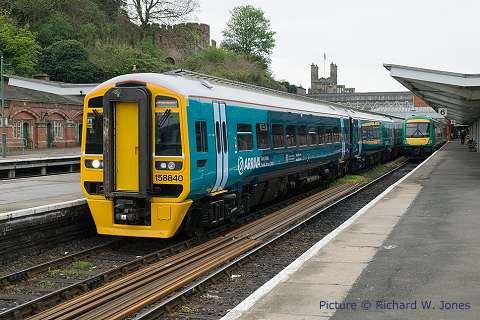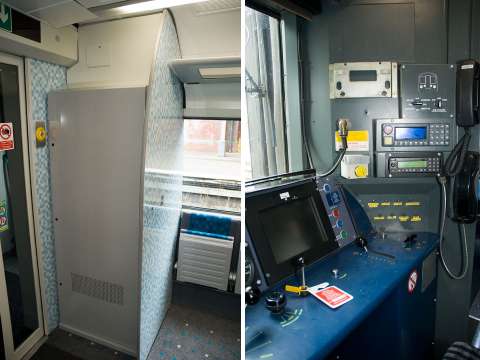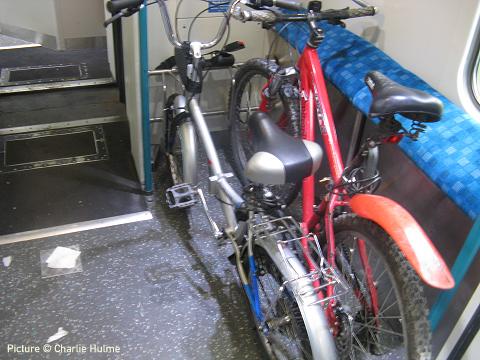Transport for Wales
Class 158 fleet
Livery: TfW Grey and Red
158 818 52818 57818
158 819 52819 57819
158 820 52820 57820
158 821 52821 57821
158 822 52822 57822
158 823 52823 57823
158 824 52824 57824
158 825 52825 57825
158 826 52826 57826
158 827 52827 57827
158 828 52828 57828
158 829 52829 57829
158 830 52830 57830
158 831 52831 57831
158 832 52832 57832
158 833 52833 57833
158 834 52834 57834
158 835 52835 57835
158 836 52836 57836
158 837 52837 57837
158 838 52838 57838
158 839 52839 57839
158 840 52840 57840
158 841 52841 57841

The Class 158 diesel railcars were built from 1989 to 1992 at Derby Works, being the final development of the British Rail 'Sprinter' concept, and among the very last trains to be built for the nationalised railway.
All the TfW 158s still in use in 2025, although two of them were damaged in a collision on the Cambrian line. however they are soon to be replaced by the new standard Class 197 units.
They exist in both 2-car and 3-car versions; most are fitted with Cummins engines, but a batch of 2-car sets has Perkins engines; all Transport for Wales (TfW) units are of this latter type. Originally the fleet inherited by Arriva Trains Wales was larger, but some were transferred away to other companies from 2006 when all the Class 175 fleet became available, leaving 24 Class 158 sets in TfW service, owned by Angel Trains and leased to the KeolisAmey franchise holder which took over in October 2018.
In 2018, 158s work all services on the Cambrian lines west of Shrewsbury, the Holyhead - Cardiff service and most trains on Arriva's services to Birmingham International as well as some Manchester - North Wales. They also appear on the Cardiff - Cheltenham route and appear on other long-distance services when stock shortages occur. General maintenance is carried out at a purpose-built new depot at Machynlleth on the Cambrian lines.
Like the Class 175s, 158s are not currently permitted on the Wrexham - Bidston and Conwy Valley lines, due to the longer station stops needed because the doors are at the ends and open slowly. There is also said to be a risk that the 'yaw dampers' on the bogies might strike some of the platforms on the Conwy Valley line.
The Cambrian lines used Radio Electric Token Block signalling from 1989 to 2011: all TfW 158s were fitted with this equipment, which was replaced by the new European standard ERTMS equipment which Network Rail have volunteered to try on the Cambrian lines. 158 829 was the first to be fitted, and was used for overnight trials from late 2008. The fitting of the new equipment requires a cabinet to be installed in the passenger compartment, replacing part of a luggage rack at one end of one vehicle. Initially a problem was encountered with sunlight affecting the driver's view of the system's display screen, but this has been overcome.
After a pilot implementation on the Harlech - Pwllheli section for a few months, the ERTMS system, with its control centre at Machynlleth, finally took over the whole Cambrian system from Sutton Bridge Junction, Shrewsbury to Aberystwyth and Pwllheli, from March 2011.
Refurbishment
A programme to refurbish the passenger facilities of the 158s, funded by the Welsh Assembly Government, began in 2010, and the first completed unit, 158 840, returned to traffic at the end of April 2010, featuring a new two-tone blue colour scheme similar to that applied to Arriva's loco-hauled stock. The seating layout has been altered, with fewer facing seats around tables than before, and improved wheelchair and cycle facilities provided as well as new upholstery. 158 838 was the second to be treated, being released from Arriva's LNWR works at Crewe in early May 2011, with others every six weeks or so, the final one being completed in October 2012.
Two interior views of a refurbished unit, showing the ERTMS cabinet (left) and the cab with its display screen for the driver.

The improved bicycle space with 'perch seat'
Technical data (TfW units)
Engine: Each vehicle has a Perkins diesel 2006-TWH of 350hp at 2100 rpm, driving one bogie.
Transmission: Hydraulic, Voith T211r
Maximum speed: 90 mph (145 km/h)
Body structure: welded aluminium
Length: 22.57 metres each car
Will work in multiple with: Class 142-144, 150, 153, 155, 156, some Class 170.
Weight of each coach: between 37.5 - 38.5 tonnes.
Toilets: one per car
Doors: Bi-parting swing plug type
Couplers: BSI automatic between sets, semi-permanent bar within sets.
Brakes: Disc, electro-pneumatic operation.
Compiled by Charlie Hulme 2018. Comments welcome